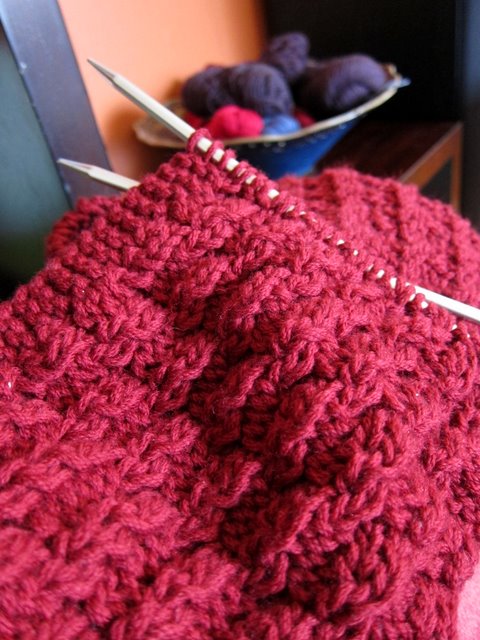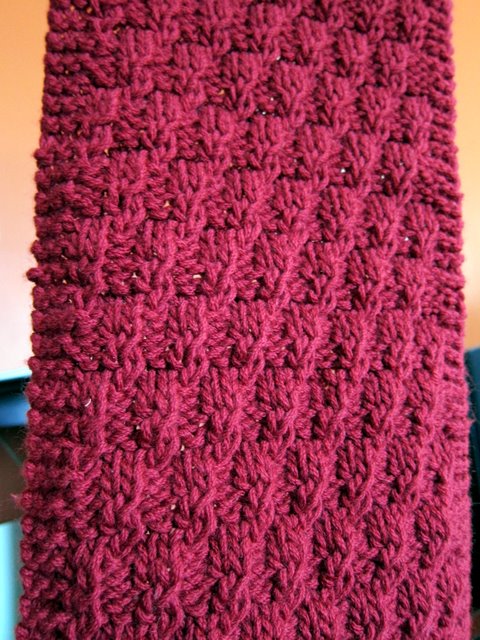With how brutally cold it's been, it's depressing to think we are just a month into winter. It seems like Kansasians have given into the permanence of the cold. Random comments about how 'nice' it is outside can be overheard when the thermometer inches above the 20 degree mark. It's possible the lack of sun has made us delirious.
Needless to say, it is time for heavy duty knit ware. Lace and silk are nice and all, but these balmy 5 degree days demand wool and cables. Designed the below for the fella. I wanted a guy-friendly design that wasn't just ribbing and a rolled up cuff so he can double up on his ears. I really love the outcome, and it was a really fast knit (2 days of fairly regular knitting).
[img:1]
Men's Cabled Hat Pattern
Size
Adult Women's/Men's
Gauge
18 sts = 4 inches in stockinette
Materials
- One skein (4 oz, 190 yards) Lamb's Pride Worsted weight. 85% wool, 15% mohair
- Size 8 (5 mm) 32” circular needles for magic loop method or DPNs, depending upon preference
- Cable Needle
- Darning needle
Abbreviations
K – Knit
P – Purl
K2tog – knit 2 together
Ssk – Slip 2 stitches knitwise and k2tog
Sl, k2tog, psso – Slip on st to the right needle, k2tog, pass slip stitch over
CL – Cable Left – Slip 3 sts to cable needle, hold to front, k3 from left needle, k3 from cable needle
CR – Cable Right – Slip 3 sts to cable needle, hold to back, k3 from left needle, k3 from cable needle
Directions
Cable cast on 80 (90) sts
Ribbing
*P2 (3), k3, p2 (3), k3, p3, k3* Repeat from * to * around until ribbing measures 2.5 (3) inches.
Body of Hat
Work the following pattern three times
-
Work 6 (7) rows of *P2 (3), k3, p2 (3), k9* Repeat from * to * to end of round.
-
*P2 (3), k3, p2 (3), CR, k3* Repeat from * to * to end of round.
-
Work 6 (7) rows of *P2 (3), k3, p2 (3), k9* Repeat from * to * to end of round.
-
*P2 (3), k3, p2 (3), k3, CL* Repeat from * to * to end of round.
Men's only. Work the final round of the last repeat as:
-
*P2, ssk, k1, k2tog, p2, k3, CL* Repeat from * to * to end of round.
[img:2]
Crown
*P2, k3, p2, ssk, k5, k2tog* Repeat from * to * to end of round.
*P2, k3, p2, k7* Repeat from * to * to end of round.
*P2, k3, p2, ssk, k3, k2tog* Repeat from * to * to end of round.
*P2, k3, p2, k5* Repeat from * to * to end of round.
*P1, ssk, k1, k2tog, p1, k5* Repeat from * to * to end of round.
*P1, k3, p1, k5* Repeat from * to * to end of round.
*P1, k3, p1, ssk, k1, k2tog* Repeat from * to * to end of round.
*P1, k3* Repeat from * to * to end of round.
*P1, k3, p1, sl1, k2tog, psso* Repeat from * to * to end of round.
*P1, k3, p1, k1* Repeat from * to * to end of round.
*P1, sl1, k2tog, psso, p1, k1* Repeat from * to * to end of round.
*P1, k1* Repeat from * to * to end of round.
Ssk around.
Cut yarn and pull end through remaining sts.
Weave in ends.
[img:3]
Edited 1/24/11 to correct ribbing and final round before crown.
Edited 3/28/11 to change k3 to k1 on 7th round of crown.
Edited 4/11 to add note about magic loop







